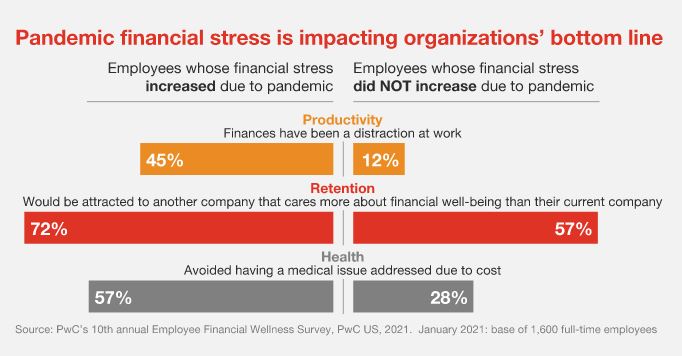Updated August 2024
63% of employees report financial stress that is impacting productivity, per a recent report from PwC. Explore ways that employers can help.
As your employees return to work this summer or fall, how are they? We’ve talked about the stress and mental health toll that the pandemic has taken. And financial stress is among the primary factors contributing to employee worries. According to PwC’s 10th annual Employee Financial Wellness Survey (PwC US, 2021), 63% of employees say that their financial stress has increased since the start of the pandemic, This stress is more pronounced among younger employees than older generational cohorts, with 72% of Millennials, 68% of Gen Z, 62% of Gen X, and 46% of Boomers reporting financial stress.
What’s more, PwC reports that this financial stress is having an impact on the employer’s bottom line in terms of productivity, retention, and physical health. From the survey:

Employers can’t assume that employees are financially OK simply because they are employed. They may have a spouse who is/was unemployed during the pandemic, or they may have additional pressures trying to help children, parents, or extended family members. And we can’t blame it all on the pandemic. Even without the financial stressors that the pandemic added, research shows that 40% of Americans struggle to pay an unexpected $400 bill, according to a 2018 report issued by the US Federal Reserve.
Among steps that PwC suggests employers take to address the stress that is impacting their bottom lines:
- Make a commitment to employee financial wellness as an integral piece of your organization’s total wellness culture.
- Understand and be aware of the financial stress your employees are experiencing.
- Offer personalized benefits to help meet your employees’ needs.
- Implement a technology solution paired with human interaction and guidance.
PwC says that, “With more than 50% of financially-stressed employees embarrassed to ask for help with their finances, employers need to ask about their financial health in ways that preserve employee dignity and privacy. Employee financial assessments can pinpoint where people are struggling and enable organizations to focus and personalize resources for their most vulnerable populations.”
ESI EAP offers benefits to address employee financial stress
As an Employee Assistance Program, we understand the many stressors that workers can experience and the impact on day-to-day productivity. When problems start affecting work, it creates even more stress and pressure. Our purpose is to offer benefits and services that help employees address and resolve productivity-draining problems that they may be experiencing.
We recognize that employee financial health and security is a fundamental need. We offer employee members and their families a suite of tools specifically to address financial stress and to promote employee financial wellness. It’s a way for employers to offer employees help while affording the dignity, privacy, and confidentiality employees need to feel comfortable. These tools include:
- Personal Financial Coaching: One-on-one Personal Financial Coaching with a certified Personal Finance coach to help with student debt, home purchasing, saving and spending, retirement planning, and creating a budget.
- Personal Finance Training: Members have access to more than 200 online Personal Finance Trainings. These are available 24/7/365 individually or as a great adjunct to Financial Coaching.
- Financial Calculators: More than a hundred online calculators help with budgeting, saving, and “what if” scenarios for rent vs buy on cars and homes, as well as for retirement planning and budgeting.
- Lifestyle Savings Benefit: Access to an ever-changing array of thousands of discounts and cash-back offers on popular brand name food and clothing, home electronics and technology, furnishings, travel, and more.
- Video training library: Self help trainings on personal finance, reducing debt, building budgets, and attaining financial goals.
- Tools for Tough Times: Online resource center with money-saving ideas, articles, and resources to solve problems, reduce costs, and do more with less.

